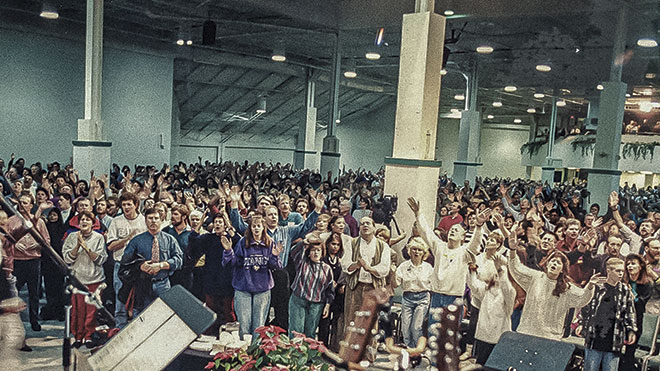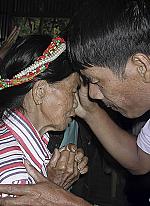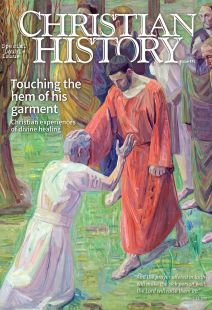Healing power

[Above: Toronto Blessing, 1994. Courtesy of Beautiful Feet ]
Very early on a Monday morning in February 1978, pastor John Wimber (1934–1997) got a worried call from a church member. “My wife is sick with a fever,” the man explained. “I just got a brand new job, and I’ve got to go to work today. I can’t stay home and take care of the kids, and we can’t find a babysitter. Can you come and pray for her?”
One might think that Wimber, the 44-year-old pastor of a new Calvary Chapel in suburban Yorba Linda, California, would have been happy to get a call like this, encouraged by his parishioner’s faith that God might intervene in the midst of a difficult situation.
With the benefit of hindsight, knowing that Wimber would go on to become a globally famous healing evangelist inseparably associated with the movement known as “the Third Wave of the Holy Spirit,” one might think that he would have been entirely confident to minister healing to this man’s wife. But it was not so. In fact when Wimber received this call, his heart sank. He did not know how to heal anyone.
Imitating Jesus
Since coming to Calvary Chapel Yorba Linda 10 months earlier, Wimber had preached exclusively about Jesus’s life and ministry as described in Luke. He intended to establish a foundational conviction in his growing young congregation that Christian discipleship is fundamentally about worshiping Jesus as God, learning Jesus’s word through studying the Bible, and, above all, imitating Jesus’s works.
Christians who highly value the Bible should, Wimber thought, understand themselves in the first place as apprentices of Jesus, people who choose to obediently and joyfully try to do the things that Jesus taught his disciples to do in the New Testament. As Carol Wimber, his wife and ministry partner, would later describe it, Christians should “read Scripture as learners and doers,” aiming not just to know the stories of the Bible but to enact them in the contemporary world. And that meant healing the sick.
Wimber had been praying for the sick in his church every week for the past 10 months, but no one had been healed. He had tried everything. He had preached about Jesus’s methods of healing. He had offered examples of healing events from church history. He had taught a practical biblical theology of healing prayer that placed the burden of outcomes on God’s sovereignty, rather than on any weakness in the person praying or the person receiving prayer. He had given altar calls at which he had personally prayed for scores of sick people, as well as inviting congregants to pray for the sick alongside him.
Over hours and weeks together, they had prayed lengthy, Bible-soaked petitions for God’s merciful intervention, as well as short, commanding prayers in Jesus’s authoritative style—“Be healed!,” “Stretch forth your hand!,” and so on. But absolutely nothing had worked. In fact some of the people who were praying for the sick actually caught the contagious sicknesses they were trying to heal!
As these months of failure wore on, Wimber began to experience desperate existential questioning. As a pastor rooted in the evangelical Quaker tradition, he had profound faith in the power of simple, worshipful obedience to the commands of Jesus as found in the text of Scripture. He knew that this way of life is what he wanted to teach his people. Furthermore, as a former traveling consultant with the Institute of Evangelism and Church Growth at Fuller Theological Seminary, he had seen firsthand that the most evangelistically effective churches around the world are the ones that claim signs and wonders like those seen in the New Testament (see pp. 44–46).
Finally, as a father, he had personally prayed some 15 years earlier for healing for his three-year-old son, Sean, who had been stung by bees all over his body, and had seen Sean’s welts disappear in a matter of minutes. But none of this background conviction bore any weight for him if the practice of healing prayer did not result in actual healings in his present moment.
The night before Wimber received that Monday morning phone call, his frustration about all this failure had boiled over at the end of yet another long, fruitless, postservice prayer session. In a moment that he later narrated in his book Power Healing (1987), he began to yell at God right in the middle of the church auditorium before witnesses. “It’s not fair!” he shouted. “You tell us to teach what your book says, but you don’t back up our act. Here we are; we’re doing the best we can do—and nothing happens. You tell us to believe in healing and pray for healing, but you’re not doing anything. Oh, God, it’s not fair!”
Next morning he went to pray for his parishioner’s wife. Laying his hand on the feverish, miserable woman, he “mumbled a faithless prayer, then . . . turned around and began explaining to her husband why some people do not get healed.” In the middle of Wimber’s explanation, the husband began to stare over Wimber’s shoulder. “I turned around to see his wife out of bed, looking like a new person,” Wimber wrote. “‘I’m well,’ she said. ‘You healed me. Would you like to stay for some coffee?’” Bewildered and overwhelmed, Wimber declined her offer and headed for his car. As he drove away, his bewilderment turned to joy and he shouted to himself, “We got one!”
At last Wimber had a contemporary experience to match his convictions about biblical discipleship. Furthermore his months of failure to heal reinforced his teaching that contemporary healing ministry has little to do with personal giftedness and everything to do with obedient discipleship and God’s surprising mercy. The ministry of healing, he taught, is for every Christian.
Power evangelism
The floodgates opened. Parishioners regularly shared stories of physical and emotional healing at Wimber’s church as they integrated practical supernaturalism into their discipleship. In 1982 the church separated from the Calvary Chapel Association and became the Anaheim Vineyard; that year Wimber publicly stated that the church was reporting more than 50 healings per week. The church also grew exponentially, gathering more than 3,000 people weekly only five years after the congregation formed.
Much of this growth resulted from what Wimber called “power evangelism”—new believers coming to faith as a result of encountering the power of the living God. On one occasion when Wimber invited hippie evangelist Lonnie Frisbee (1949–1993) to preach, the congregation was so galvanized by encountering what felt like the tangible power of God in prayer that many took to the streets to evangelize the neighborhood.
Within three months the church had baptized over 700 people in backyard swimming pools around Yorba Linda. The combination of the proclamation of the gospel of Jesus with a demonstration of the power of God was, Wimber believed, just as attractive and transformative in the 1980s as it was in biblical times.
The rapid growth of Anaheim Vineyard caught the attention of Wimber’s former colleague at Fuller, Professor C. Peter Wagner (1930–2016). Equal parts evangelical futurist and puckish impresario, Wagner had for some time contended, based on global trends, that “pentecostalization” is the future of the American evangelical church. The flowering of Wimber’s ministry at Anaheim Vineyard offered him an example he could sell.
Here was a church that integrated Pentecostal “signs and wonders” with a nondispensational evangelical theology of the Kingdom of God, drawn from the work of Fuller professor George Eldon Ladd (1911–1982), and a winsome come-as-you-are fallibility that made such ministry seem within reach of any Christian.
Wagner proposed that he and Wimber team-teach an experimental course, “MC510: Signs, Wonders, and Church Growth,” in 1982 at Fuller’s School of World Mission. They would demonstrate the healing practices that Wimber had discovered in a practical clinical environment, while also teaching the evangelical worldview undergirding them.
Wagner believed this would allow him to advocate for what he named “the Third Wave of the Holy Spirit” in the twentieth century, in which evangelical pastors—theologically and stylistically at odds with both classical Pentecostals (the “first wave”) and mainline Charismatics (the “second wave”)—could embrace supernatural power in their ministries.
“This number may change your life”
The course succeeded beyond Wagner’s wildest imagination. Controversial from the first, every session involved an explanation of theological foundations, followed by a Wimber-led clinic in which students practiced praying for healing.
Most sessions involved testimonies of healings that had taken place in a prior session. Wagner himself professed healing from high blood pressure during the first class. By the end of 1982, there was enough national buzz about the course that Christian Life, a widely circulated magazine for pastors, published an entire issue on it, declaring on the cover: “MC510: This Number May Change Your Life.”
Practically overnight Wimber’s world was turned on its head. He went from being the pastor of a dynamic local church to becoming the public face of Wagner’s Third Wave. He published best-selling books—most famously Power Healing and Power Evangelism (1986)—which contain all the MC510 material. He taught at hundreds of conferences, presided over the development of a groundbreaking worship music company, and, in 1985, became the leader of the newly formed Association of Vineyard Churches.
Until his premature death of a brain hemorrhage in 1997, Wimber continued to equip leaders in this Third Wave model of supernatural healing. Many prominent contemporary healing ministers in the United States and around the world count him as a forefather (see pp. 56–60), among them Randy Clark of Global Awakening, Heidi Baker of Iris Ministries, Bill Johnson of Bethel Church, Mathias Thelen of Encounter Ministries, and Mary Healy. Even more notable, perhaps, is the fact that Wimber and Wagner established a paradigm for laity-led healing prayer that continues to profoundly influence the practices of evangelical churches worldwide. CH
By Caleb Maskell
[Christian History originally published this article in Christian History Issue #142 in 2022]
Caleb Maskell is associate national director of theology and education for Vineyard USA and executive secretary of the American Society of Church History. He is coauthor of Sinners in the Hands of an Angry God: A Casebook.Next articles
Hope, wholeness, healing
Two doctors discuss prayer and medical interventions working together to promote healing
John R. Peteet, John R. Knight Jr., and the editorsTesting the power of prayer
Scientific studies of prayer for healing
Joshua W. Brown, Clarissa C. Romez, and the editorsSupport us
Christian History Institute (CHI) is a non-profit Pennsylvania corporation founded in 1982. Your donations support the continuation of this ministry
Donate







